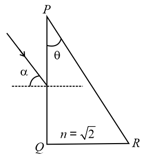HARD
Earn 100
An achromatic lens is made using a convex and a concave lens. The power of the achromatic convergent lens of two lenses is . The power of convex lens is . The ratio of dispersive power of convex and concave lenses will be
(a)
(b)
(c)
(d)
50% studentsanswered this correctly
Important Questions on Ray Optics
MEDIUM
EASY
EASY
HARD

EASY
EASY
MEDIUM
MEDIUM
EASY
MEDIUM
EASY

EASY
EASY
EASY
EASY
EASY
EASY
MEDIUM


